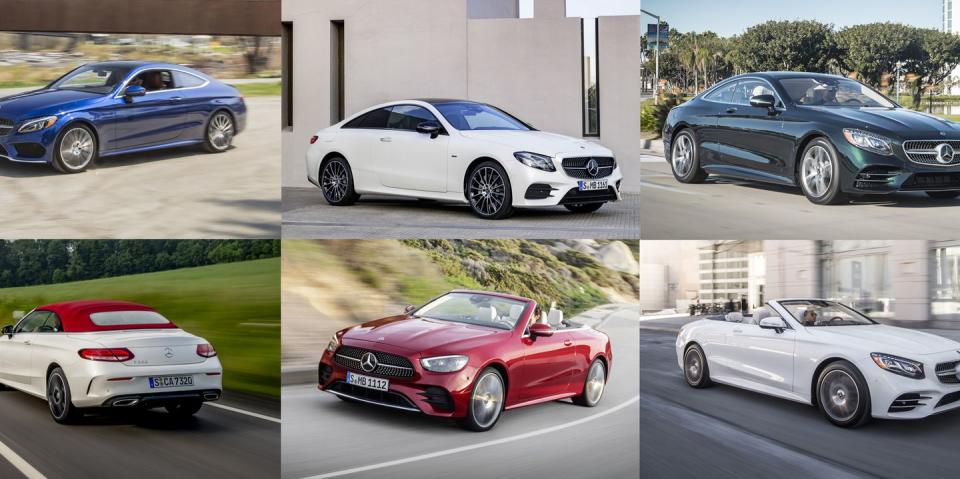Mercedes Killing 7 Models? A Good Start.

It usually takes tough times for a bloated, loosely-led corporate structure to realize it's time for a change. The coronavirus has supplied exactly that type of crisis. For the past decade or so, Mercedes-Benz, and their arch-rival BMW, have been filling their portfolios with new sub-models, body styles, and powertrain variants that left industry insiders scratching their heads. Now, we hear rumor that Mercedes is winnowing down its product line considerably, deleting seven models, all coupes and convertibles. Officially, Mercedes won't comment on this rumor. But if it's true, it's the right move. Take it from someone who knows.
I consider myself a knowledgeable car guy, and yet I couldn't possibly name half of the models that Mercedes or BMW sell today. To make matters worse, I doubt any senior executive at either company could supply, unaided, a complete list of their employers' offerings. Whether it's sedans, coupes, or crossovers, many of these models are closely spaced within ever-narrower niches of an overcrowded market. The buying public neither notices nor cares. BMW X1, X2, X3? On the road, they look nearly identical. Some are front-wheel drive? That minor technical detail is lost on the customer, who is likely chasing a low lease payment and will pick whichever one costs less per month.
What about high-performance roadsters? I have a good friend who likes to buy large, uber-powerful Mercedes convertibles from dealers that have been sitting on them for two years. They're glad to entertain any offer, even at $100,000 off list price. The much-acclaimed BMW i8 has been a commercial disaster, with dealers heaving a sigh of relief when their last heavily-discounted unit finally leaves the lot.
All of these are vehicular answers to questions nobody asked, and they are costly. Every new variant consumes engineering resources and capital for plants and equipment. Worse, each drives massive added complexity through the whole corporate system, whether it's financial tracking, purchasing, parts supply, service literature, technical training, warranty coverage, or marketing. The worst added cost comes at the tail end, in the form of incentives and heavily subsidized leases to force the unloved (and mostly unknown) products into the hands of customers. Marketing budgets, as huge as they are, have limits. If a company can focus one to three billion dollars on, say, five vehicles, it's possible to generate awareness for all. But spread that same money over 25 to 30 market entries, and you're below the awareness threshold on every one.
Lee Iacocca had sage advice on the matter: "Don't plant too many goddamn flowers. At some point, you can't pee on all of them." Earthy, but fundamentally wise. Dealers hate portfolio proliferation. They like their inventory to be full of popular, identifiable, fast-moving entries—a lean selection that ensures that the salespeople are knowledgable, the technicians are trained, and the parts department is fully stocked. A portfolio free from factory-mandated cram-downs, which dilute a dealer's finances and sales focus.
"If this is all so bad, how does it keep happening?" the reader may well ask. The answer lies in an internal function, present in all automobile companies: Product planning. The product planners are almost always a large staff. They tend to be young, highly intelligent and brilliantly numerate. They are usually not "car people," but could easily exchange jobs with the finance staff. Their job description is to find unfilled market niches or, better yet, create new ones. Failing that, they pore over intelligence on impending competitor introductions and advise management that their company needs to counter with a new model of their own.
Product planners always forecast enough volume and profitability to justify another model. The problem is, they don't see the reality of the retail environment, where most of these derivative models end up substituting for one another, rather than adding to total sales. Portfolio proliferation, as seen at BMW and Mercedes, is usually a sign of a CEO who manages, rather than leads. Such an executive lets "the system" run itself, rather than leading it, making demands, and at times, setting limits on the product planners. A good CEO sees, or should see, the big picture, and acts with the long view in sight. "You can have this many market entities, period. Beyond that, we cancel one old model for every new one."
As the enthusiastic father of many highly-acclaimed but low-selling performance vehicles, I learned this lesson the hard way. Did the world really need a Cadillac CTS station wagon? Available with or without all-wheel drive? And a high-performance V-Series version to boot? I thought it did. Nobody stopped me—but somebody should have.
You Might Also Like

 Yahoo Autos
Yahoo Autos 